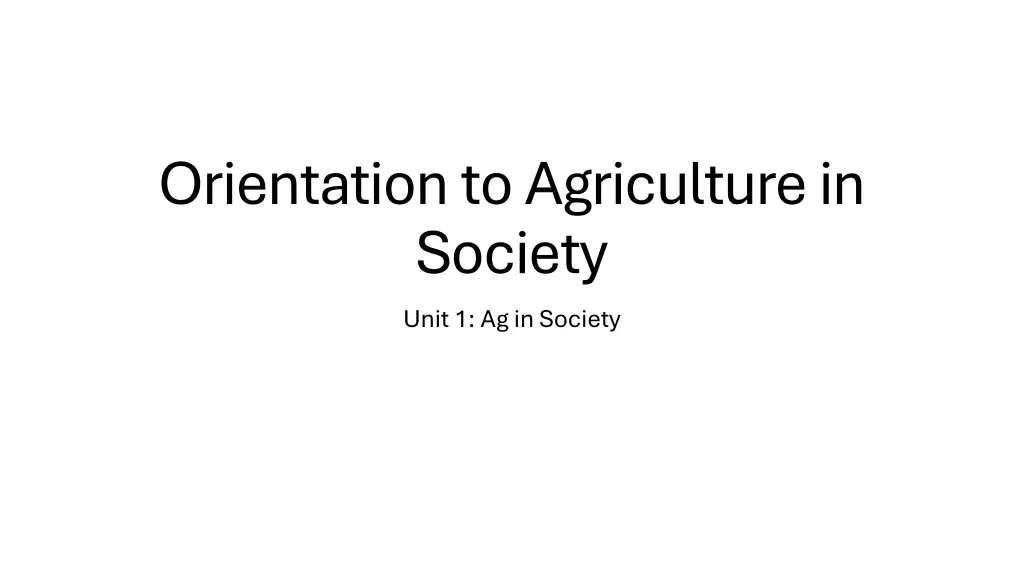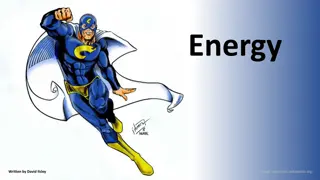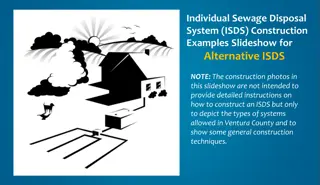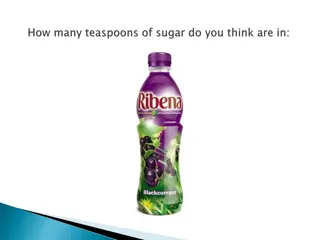
Understanding Agriculture and Its Impact on Society
Explore the significance of agriculture in society, its role in feeding the world, and the sciences involved. Discover how agriculture impacts your daily life and learn about the challenges of food insecurity in a growing population.
Download Presentation

Please find below an Image/Link to download the presentation.
The content on the website is provided AS IS for your information and personal use only. It may not be sold, licensed, or shared on other websites without obtaining consent from the author. If you encounter any issues during the download, it is possible that the publisher has removed the file from their server.
You are allowed to download the files provided on this website for personal or commercial use, subject to the condition that they are used lawfully. All files are the property of their respective owners.
The content on the website is provided AS IS for your information and personal use only. It may not be sold, licensed, or shared on other websites without obtaining consent from the author.
E N D
Presentation Transcript
Orientation to Agriculture in Society Unit 1: Ag in Society
What is Agriculture? Unit 1 Lesson 1
Lesson 1 Objectives Define agriculture and describe its impact Explore agriculture's role in feeding the world Summarize sciences used in agriculture Discover agriculture in your own community
What is Agriculture? Think of everything you ve done in the last 24 hours Put on clothes, ate, drove to school, played sports, etc. What have you done that involved agriculture? The real question: The real question: how are you NOT involved in agriculture?
What is Agriculture? Growing and raising Growing and raising plants and animals for food, clothes, shelter shelter Agriculture helps feed the world feed the world and make money for ag producers like farmers and ranchers Can include: Agronomy Agronomy science of growing crops and managing soil Horticulture Horticulture Cultivating and growing fruits, vegetables, flowers, and other plants Livestock production Livestock production raising animals for food, fiber, or other products food, clothes,
Are You Involved in Agriculture? Even if you don t raise livestock or grow crops, how could you be involved in agriculture?
Feeding the Worlds Growing Population The world's population keeps growing The world population is currently a little more than 8 billion World population is expected to be ~9.7 billion Meaning we need more food every day Total food demand will increase by ~57% 33% 33% of food is wasted If we stay on the current trajectory, we need to produce 70% to feed the world s population and end food insecurity growing 8 billion ~9.7 billion by 2050 57% by 2050 70% more food by year 2050 food insecurity
Food Insecurity Food Insecurity Food Insecurity condition of not having access to sufficient food food to meet basic basic needs 13.5% 13.5% of US households are food insecure 15.4% of Oklahoma Oklahoma households are food insecure Projected 8% 8% increase in food insecurity food insecurity by 2050. sufficient
Feeding the World Food System Food System the sum of all activities related to food production, distribution, consumption, production, distribution, consumption, and waste. ~33% of food is wasted wasted Do you ever waste food? Do you think food waste is a problem? How are you involved in the food system? How could you get involved in the food system? What role does agriculture play in feeding the world? food waste.
The Science of Agriculture Ag producers use science What science subjects do you think they use? science to grow better, and more food
Agriscience Agriscience Agriscience field of science agriculture agriculture. Application of fields like biology, botany meteorology, chemistry chemistry, and engineering in the field of agriculture agriculture. Helps us: Grow more more food with less less land Protect the environment environment Keep animals and plants healthy healthy Increase efficiency efficiency and productivity productivity of agricultural production science that deals specifically with botany, ecology,
Sciences in Agriculture Biology: Study of living organisms Botany: The scientific study of plants Animal science: Study of livestock Ecology: Branch of biology that deals with relationships one another and to their surroundings surroundings Meteorology: Branch of science dealing with weather atmosphere atmosphere Chemistry: Study of matter matter and its properties Engineering: Design, building, and use of engines, machines, and structures structures living organisms like animals and plants plants livestock and other animals relationships of organisms to weather and the engines, machines, and
How Could Each of these Sciences be Used in Agriculture? Biology Meteorology Chemistry Engineering
Agriculture in Our Community You will learn about agriculture class You will have an SAE Supervised Agricultural Experience Student-led, instructor supervised learning experiences outside classroom You can join FFA FFA Intracurricular Intracurricular student organization for those interested in agriculture and leadership leadership Local activities can include: __________________________________ agriculture and its impact to society society in this SAE outside the agriculture
Unit 1 Lesson 1 Review What is agriculture? How does science help farming? How can you learn about agriculture in your school? Key terms: Key terms: Agriculture, livestock, agronomy, horticlture, food insecurity, food system, agriscience, FFA, SAE
Significance of Agriculture Unit 1 Lesson 2
Lesson 2 Objectives Summarize the history of agriculture from hunting and gathering to today Create a timeline outlining agricultural history in the US Discover where food is grown in the US Locate where food is grown in Oklahoma Explore careers in agriculture
History of Agriculture Long ago, people hunted and gathered hunted and gathered for food. Then they started farming this is called domestication Farming allowed people to build society Cities and communities, art, sports, comforts and safety all exist because of agriculture agriculture They began trading farm products, called commodities domestication. society commodities.
History of Agriculture Independent Research What were the first animals domesticated? Where were they domesticated, and why? What impact did that have on the peoples who domesticated the animals? What were the first plants domesticated? Where were the first plants domesticated, and why? What impact did that have on the peoples who domesticated the plants?
History of Agriculture in the US Before 1492 People cultivated crops like maize, Sustainable production for small communities 1500-1700 Staple crops included corn, tobacco, wheat, barley corn, tobacco, wheat, barley Cattle, , pigs, chickens and horses were imported Tobacco dominated crop markets in places like Carolinas and Virginia 1700-1800 Grain, Dairy, Livestock Grain, Dairy, Livestock were grown in the northern US Cotton, Rice, and Tobacco Cotton, Rice, and Tobacco were grown in the southern US Plantation Economy Plantation Economy System of large-scale ag production, reliant on a specific cash crop like cotton Relied on enslaved African Labor enslaved African Labor maize, beans, tobacco imported and produced produced
History of Agriculture in the US 1800-1860 Ag production in the Midwest Steel plow Steel plow and mechanical reaper South continued to produce high levels of cotton 1860-1900 Homestead Act Homestead Act deeded new lands to potential ag producers, increasing production Railroad expansionboosted grain grain and livestock livestock markets USDA USDA is created Morrill Act of 1862: Morrill Act of 1862: Granted states federal land to establish colleges (Land Grant Schools) Oklahoma State University Oklahoma State University is a land grant school Focus on agriculture agriculture and mechanical arts Cattle Drives Cattle Drives move cattle from plains areas to markets in places like Kansas Chisholm Trail: Chisholm Trail: Cattle trail that started in Texas and went through Oklahoma. Highway 81 the same route Midwest grew, including crops like wheat mechanical reaper improved ag production efficiency cotton wheat and corn corn Kansas Highway 81 follows
History of Agriculture in the US 1900-1930 FFA FFA is founded Chemical fertilizers Mechanized agriculture Mechanized agriculture began to increase ag production, especially in crop production Tractors Tractors and other mechanized equipment replaces animal 1930s Dust Bowl Dust Bowl Environmental disaster that affected areas of Oklahoma New Mexico Caused by poor poor soil conservation practices and overproduction New Deal Efforts New Deal Efforts included programs to improve farming conditions in the Great Plains Soil Conservation Service was started to combat soil erosion fertilizers and pesticides pesticides are being to see adoption on US farm animal labor Oklahoma, Texas, Kansas, Colorado, and erosion and restore degraded land land
History of Agriculture in the US 1940-1970 Ag productivity continues to increase because of: hybrid synthetic synthetic fertilizers, and mechanization US increases participation in global food markets 1970-2000 Growth of niche niche food markets like organic labeling The first commercially-available GMO These include tomatoes, corn corn, cotton, soybeans, and canola 2000-Present Consumers have more more choices in their food than ever before Use of precision agriculture precision agriculture improves efficiency hybrid seeds, organic labeling GMO is introduced
Agriculture in the United States Today The U.S. is a leader Commodities: Commodities: materials or products that can be bought or sold Including crops like corn and beef Farmers will produce a commodity commodity like cattle or corn and sell That commodity is then processed and turned into something useful Turning cattle into steaks leader in agriculture production around the world sell it useful Agriculture and food add money to our economy US ag and food industries support more than 19 million jobs employment) Less than 2% 2% of all people are directly involved in production ag GDP: GDP: Gross Domestic Product Country s total value value of goods and services Agriculture and food industry makes up about 6% 19 million jobs (10% of US 6% of the US GDP
Agriculture in Oklahoma Oklahoma s top commodities include: Cattle, Wheat, Pork, Cattle, Wheat, Pork, Poultry Poultry Farming is a big part of our state s identity and economy There are more than 86,000 Oklahoma Supports more than 188,000 Agriculture adds $9.8 billion Oklahoma GDP 86,000 farms in 188,000 jobs $9.8 billion to
Careers in Agriculture You don t have to be a farmer to work in agriculture! You can be a scientist scientist, teacher, truck driver, engineer, or even a lawyer lawyer. You can try out careers with SAEs SAEs, CDEs Don t know if an ag career is in your future? Take the MyCareer Quiz https://agexplorer.ffa.org/ Write down your top 3 ag careers based on the results of the test CDEs, and LDEs LDEs through FFA FFA.
Lesson 2 Review What did early farmers do? What does Oklahoma grow or raise? What career in agriculture sounds fun to you? Key Terms: Key Terms: Domestication, Commodities, GDP, Career, Livestock, Agronomy, Horticulture, CDE, LDE
Orientation to Agricultural Education and FFA Unit 1 Lesson 3
Lesson 3 Objectives Name and describe the components of the 3-circle model Recite the FFA motto and mission statement
Agricultural Education and the 3-Circle Model Describes what a student's experience experience in agricultural education should look like Helps students gain knowledge knowledge, practical experiences experiences, and leadership leadership skills to succeed in an agricultural career career
Classroom/Laboratory Instruction Formal Formal learning in both the classroom and laboratory It's what you are experiencing right now In this class, you will learn about the foundations of agriculture and its impact on society society agriculture
Supervised Agricultural Experiences Allows students to gain hands classroom Students will take what they learn in the classroom the outside outside world You will design design, participate participate, and reflect hands- -on on experiences outside of the classroom and apply it to reflect on a project this year
SAEs and Record Keeping SAE SAE: A project you work on like growing a garden or raising a pig You learn by doing You must track your progress using record keeping SAEs can vary from student to student, but each student will: Develop an SAE plan that focuses on their interests Participate in experiences or activities activities related to their SAE Keep records records of their plan on AET AET record keeping interests
FFA Leadership Leadership organization that provides opportunities for personal growth growth, career development career development, and community service community service Students can participate in leadership leadership training, competitions travel travel opportunities, and team building experiences FFA members develop critical skills like teamwork teamwork, communication communication and problem-solving personal competitions, team
FFA Motto and Mission FFA Motto: FFA Motto: "Learning to Do FFA Mission Statement: FFA Mission Statement: FFA FFA makes a positive difference their potential for premier success success through agricultural education agricultural education Do, Doing to Learn Learn, Earning Earning to Live, Living Living to Serve Serve" difference in the lives of students premier leadership, personal growth students by developing growth, and career
Lesson 3 Review What are the 3 parts of ag education? What does FFA help you do? What kind of SAE would you like to do? Review Words: Review Words: 3-Circle Model, FFA, SAE, CDE, LDE, Career
Unit Review What is agriculture? Why is it important in your community and the world? How can YOU be involved in agriculture? Challenge Question: How can you use what you ve learned to help others or solve problems?






















